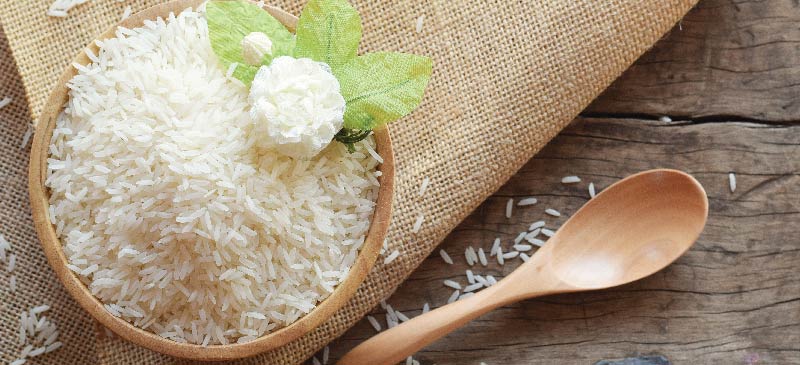
Earning its name from the fragrant jasmine flower, jasmine rice is an aromatic, long-grain rice that is favored for its unique taste and texture. Native to Thailand, this popular ingredient is prominent in southeast Asian cuisine and can be spotted in dishes ranging from curries to stir-fries.
In addition to being versatile and easy to prepare, jasmine rice nutrition also brings a host of nutrients to the table, including manganese, folate, selenium and iron. Plus, whole grain varieties may be associated with even more benefits, including improved heart health, decreased oxidative stress and protection against chronic disease.
What Is Jasmine Rice?
Jasmine rice is a type of long-grain rice known for its floral aroma and soft, sticky texture. Although it’s grown primarily in Thailand, Cambodia, Vietnam and Laos, jasmine rice has become a pantry staple around the globe thanks to its sweet and subtle flavor.
It’s a bit shorter and thicker than other types of rice, such as basmati, and has a clingy texture that makes it well-suited for eating with chopsticks. It also has a unique signature scent, which is due to the plant’s natural production of aromatic compounds like 2-acetyl-1-pyrroline.
This compound is also found in other foods, such as white bread and basmati rice, and is said to have a scent similar to hot buttered popcorn.
Like other types of rice, both white and brown jasmine rice are available. While white rice has undergone processing to remove the bran and germ, brown rice is a whole grain that contains all three parts of the rice grain.
Although less common, red, purple and black rice varieties are available from specialty retailers as well.
Jasmine Rice Nutrition Facts
Although the jasmine rice nutrition label can vary a bit depending on the specific variety, most types are high in carbohydrates, along with micronutrients like manganese, folate, selenium and niacin.
One cup (about 158 grams) of cooked white jasmine rice nutrition contains the following nutrients:
- 205 calories
- 44.5 grams carbohydrate
- 4 grams protein
- 0.5 grams fat
- 0.5 grams dietary fiber
- 0.7 milligrams manganese (37 percent DV)
- 91.6 micrograms folate (23 percent DV)
- 11.9 micrograms selenium (17 percent DV)
- 2.3 milligrams niacin (12 percent DV)
- 1.9 milligrams iron (11 percent DV)
- 0.1 milligrams vitamin B6 (7 percent DV)
- 68 milligrams phosphorus (7 percent DV)
- 0.6 milligrams pantothenic acid (6 percent DV)
- 19 milligrams magnesium (5 percent DV)
- 0.8 milligrams zinc (5 percent DV)
- 0.1 milligrams copper (5 percent DV)
Compared to white rice, the brown jasmine rice nutrition profile is lower in calories and contains a bit more fiber, calcium and iron.
Health Benefits
Is jasmine rice healthy? While it is high in carbs and calories, it is associated with several health benefits when enjoyed in moderation as part of a balanced diet.
1. Good Source of Iron
With 11 percent of the daily recommended value packed into a single serving, jasmine rice is a great source of iron. Iron is an important mineral that is involved in a number of metabolic processes in the body, including DNA synthesis, oxygen transport and red blood cell production.
A deficiency in this key nutrient can lead to iron deficiency anemia, a condition characterized by symptoms like weakness, fatigue and brittle nails. Including a variety of iron-rich foods in your diet can help boost your intake and prevent against this common condition.
2. High in Antioxidants
The jasmine rice nutrition profile contains a wealth of antioxidants, which are compounds that help fight free radicals and protect against oxidative stress and cell damage. Each serving is especially high in manganese, an essential mineral that acts as an antioxidant and plays a key role in health and disease.
Certain varieties like red, purple and black rice may be even higher in disease-fighting antioxidants. A 2014 in vitro study out of Thailand, for example, found that red jasmine rice could help decrease cancer cell growth, thanks to its content of beneficial compounds, such as phenolics, oryzanol, tocotrienol and tocopherol.
3. May Promote Heart Health
Brown jasmine rice is considered a whole grain, meaning it contains all three parts of the rice kernel. Some studies show that including a few servings of whole grains in your diet could help enhance overall heart health.
READ RELATED: Which Vitamins, Minerals and Supplements Boost Your Immune System?
According to one large review of 45 studies, eating at least three servings of whole grains per day was linked to a lower risk of heart disease. What’s more, other research shows that whole grain consumption could be tied to a lower risk of stroke as well.
Another major difference between brown jasmine rice vs. white rice is the fiber content. Because brown rice contains more fiber, it could potentially help decrease levels of cholesterol and blood pressure, two major risk factors for heart disease.
4. Could Help Combat Cancer
Promising research suggests that consuming more whole grains like jasmine rice and brown rice could possibly help reduce the risk of cancer. In fact, one paper published in Nutrition Reviews compiled the results of 20 studies and found that six showed that whole grain intake was associated with a significantly lower risk of developing cancer over time.
Brown rice contains a higher amount of fiber, which may also beneficial against certain types of cancer. In fact, studies show that increasing your intake of fiber may be linked to a lower risk of colorectal, ovarian, head and neck, and breast cancers.
5. Promotes Healthy Pregnancy
The jasmine rice nutrition profile is brimming with folate, knocking out nearly a quarter of the recommended daily value in a single cup. Folate, also known as vitamin B9, becomes especially important during pregnancy as it plays a central role in fetal growth and development.
Within the past few decades, food manufacturers have begun adding folate to enriched foods such as pasta, rice, bread and other grains. This can help protect against neural tube defects in infants, which is a type of birth defect that affects the brain, spine or spinal cord.
How to Make It (Plus Other Recipes)
There are several different methods for how to cook jasmine rice, but most generally involve adding the rice to water, bringing it to a boil and then letting it simmer for around 15 minutes or until all of the water is absorbed. As a general rule of thumb, you should use about 1.5 cups of water for each cup of rice, but you can also adjust depending on how soft you like it.
You can swap jasmine rice in for other types of rice in many of your favorite recipes, including stir-fries, soups and side dishes. It also works well paired with curries or used as a base for fried rice or rice bowls.
Need a bit more inspiration? Here are a few delicious jasmine rice recipe ideas that you can try at home:
Risks and Side Effects
While jasmine rice can be an excellent addition to a balanced diet for most, there are some risks and side effects that need to be considered as well.
For starters, it’s best to opt for brown jasmine rice over white rice whenever possible. Not only is brown rice much less processed, but it also retains a higher amount of fiber and beneficial nutrients.
Because there are a relatively high amount of jasmine rice calories and carbs in each serving, it’s important to enjoy in moderation as part of a balanced diet. Be sure to also round out your meal by pairing rice with plenty of fruits, veggies, protein foods and healthy fats.
Additionally, rice plants tend to absorb more arsenic than other food crops, which may be a concern if rice is a regular part of your meal plan. While one paper published in Environmental Health Perspectives did note that aromatic varieties like jasmine and basmati rice tend to contain the lowest amount, it’s best to alternate rice with other whole grains in your diet, such as quinoa, couscous or farro.
Although jasmine rice is naturally gluten-free, it’s important to check the label carefully if you have celiac disease or a sensitivity to gluten and look for products that are certified gluten-free. Some flavored rice mixes may contain flavorings, thickeners or additives that contain gluten.
Other products may also be manufactured in facilities that process ingredients with gluten, which can increase the risk of cross-contamination.
Finally, some people may be allergic to jasmine rice and may experience symptoms like rashes, nausea or hives after consumption. If you notice any of these side effects after eating rice, discontinue use immediately and talk to your doctor.
Conclusion
- What is jasmine rice? Jasmine rice is a type of aromatic rice known for its sweet flavor, floral aroma and soft yet sticky texture.
- Similar to basmati rice, jasmine rice contains a compound called 2-acetyl-1-pyrroline, which is responsible for its distinct aroma. However, there are several differences between basmati vs. jasmine rice in terms of appearance and texture.
- Is jasmine rice good for you? The organic jasmine rice nutrition facts boast a high amount of important nutrients, such as iron, manganese, folate and selenium.
- Brown jasmine rice is also rich in antioxidants and could help improve heart health, reduce the risk of cancer and supply several nutrients to support a healthy pregnancy.
- However, rice is generally high in carbs and calories and may contain arsenic. Therefore, it’s best to enjoy whole grain varieties in moderation as part of a healthy diet.
Source: Dr. Axe | Nutrition





